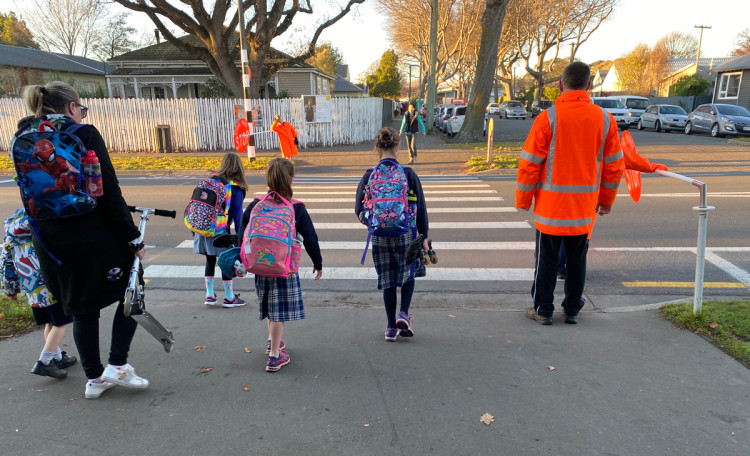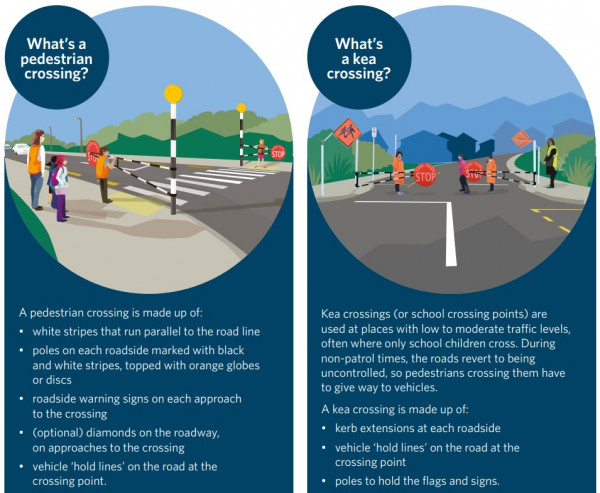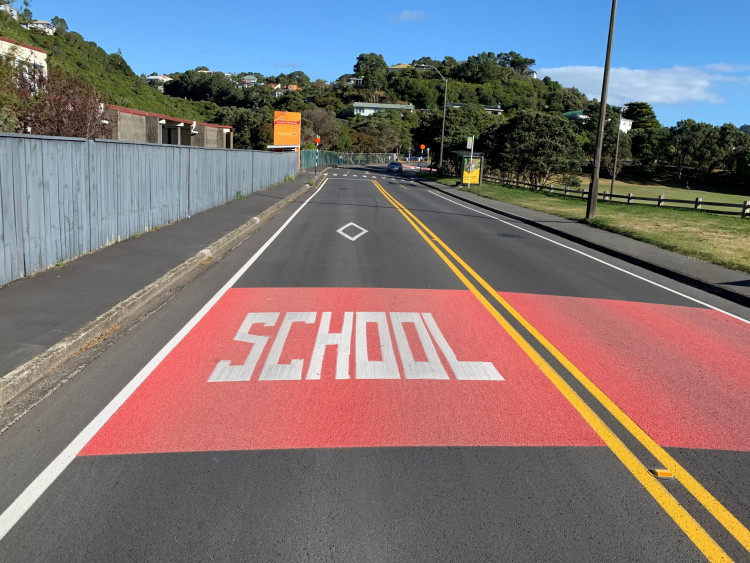School crossing facilities are introduced specifically to assist children crossing roads to and from school. Children are among the most vulnerable of pedestrians due to their limited abilities and lack of experience. Their abilities vary according to their age.
PNG: Human capabilities and states
There is some evidence[1] that the most risky part of a child pedestrian’s journey to school is when crossing busy roads further than 500m from the school gate. Planners should assess the walking networks around schools to determine whether interventions away from the school gate will improve safety and amenity for children walking to school.
If there is a nice safe crossing near school, I can walk at least part of the way home by myself. |
Crossing facilities near the school gate should also be assessed. These aspects should be considered as part of the following Waka Kotahi guidance:
Near schools the number of children walking increases to the extent that formal crossing points are typically provided near school gates. As well as children walking, cycling and scooting to school, school crossing facilities also assist children who are dropped off or take the bus to school.
Examples of school crossing facilities are shown below.

School patrolled zebra crossing, Christchurch. (Photo: Penny Gray)
Kea crossing, Christchurch. (Photo: Penny Gray)
The appropriate type of crossing facility may be influenced by the speed limit around the school and whether it is a permanent or variable speed limit in force during school travel periods.
Crossing facilities near schools experience short periods of high pedestrian flows, but may have little use outside these times. Therefore, crossing facilities that give full-time priority to pedestrians instead of vehicles may not be the best solution. Even where crossing facilities that give priority to pedestrians are the best solution, they generally require additional devices and assistance.
The crossing selection process can assist with decision making on providing crossing assistance for school children.
However, crossings mainly used by school children have two major differences from other pedestrian crossings.
Four types of crossing assistance are available for places where school children are particularly concentrated, and should be supported where appropriate by school speed zones. The table below describes the range of solutions.
Table: Types of crossing assistance for school children
|
Assistance |
Description |
|
Crossing aids (not affecting priority) |
These are devices that do not change who gives way at crossing points but make it easier for pedestrians to be able to cross. They include pedestrian refuges, raised medians, kerb extensions, pedestrian platforms and traffic calming. |
|
School warden crossing |
This involves adults or older children who guide school children on when to cross at:
Wardens do not have the use of signs to control vehicles. |
|
School patrolled zebra crossing or kea crossing |
‘School Patrol – Stop’ signs stop vehicles and allow pedestrians to cross only when it is safe. School patrols operate on zebra crossings and on kea crossings (school crossing points without zebra markings). |
|
Signalised intersections/signalised mid-block crossings |
Traffic signals stop vehicle traffic to allow pedestrians to cross the roadway. |
|
Grade separation |
Grade separating pedestrians and other road users may be necessary, for example, where school students need to cross a motorway or high speed rural road to access a school. |
Engineering devices such as physical crossing aids should be considered first as they provide benefits for all pedestrians. Reducing vehicle speeds through variable speed limits in school zones (Traffic Note 37) or traffic reduction techniques should also be considered.
Traffic note 37: 40km/h variable speed limits in school zones - guidelines [PDF, 161 KB]
Physical aids to assist pedestrians in general are discussed in more detail.
PNG: Non-priority crossing aids
Zebra crossings installed on high traffic flow and/or wider two lane streets may include a pedestrian/median refuge. It is likely to be difficult for school patrols to operate effectively at these crossings as a school patrol must not extend the ‘School Patrol’ sign into the roadway to stop a vehicle except during a pause in the flow of traffic (TCD Rule 8.3(9)) and drivers do not need to give way to pedestrians if they are waiting behind a school patrol sign (Road User Rule 10.1). This can make it difficult for both sides of the school patrol to find a gap in the traffic flow and operate effectively together. For such locations it is preferable to form a continuous single stage zebra crossing or to consider other treatments such as providing a signalised crossing.
Pedestrian platforms should also be considered for school crossings in appropriate environments.
School wardens, are adults or older children, who provide a valuable safety check for children crossing – most commonly at unmarked crossing points, but also at pedestrian crossings where no school patrols are operating and at traffic signals.
Unlike school patrols, school wardens (sometimes called traffic wardens) have no power to control vehicular traffic other than by calling a pedestrian phase at traffic signals. School wardens use their arms (as ‘barrier arms’) to stop pedestrians crossing the road until it is clear of approaching traffic. School wardens do not use stop signs, or any other sign or flag.
School wardens are the most appropriate solution at traffic signals, and for straightforward situations where light traffic flows provide ample crossing opportunities, with no need to stop traffic.
School wardens can easily find suitable gaps to cross if traffic flows are less than 500 vehicles per hour and the crossing distance is 9m or less.
PNG: ‘Crossing aids and pedestrian delay’ in Crossing selection process
School patrols are normally operated by two or three appointed children under adult supervision.
They control the flow of vehicles and pedestrians at zebra crossings and kea crossings. Operating before and after school, patrol members extend STOP signs onto the road in both directions, which signal to approaching drivers to stop. Once the vehicles are slowing or have stopped or there is no traffic, the patrol signals to waiting pedestrians that it is safe to cross the road.
When school patrols operate on zebra crossings they are called school patrolled zebra crossings. They can also operate at school crossing points without zebra markings, usually referred to as kea crossings.

Extract from the School Traffic Safety Team Manual (Source: NZ School Traffic Safety Team Manual(external link))
Kea crossings were developed to address the issue that often outside schools, the number of pedestrians wishing to cross is concentrated to before and after school times, with little demand outside of these hours.
At pedestrian (zebra) crossings this can put pedestrians at a greater risk as motorists are not expecting to see pedestrians. Kea crossings address this as the crossing operates the same as a marked pedestrian crossing with a school patrol, however when the signs and patrol are not present the crossing point reverts to a section of road where pedestrians may cross only if there is a safe gap to do so.
School patrols should be considered whenever traffic flows at before and after school times would make it difficult for school traffic wardens to find safe gaps in the traffic.
The crossing selection process gives initial guidance, suggesting that with appropriate road widths, school patrols are not needed below 500 vehicles per hour.
PNG: ‘Crossing aids and pedestrian delay’ in Crossing selection process
There is no specific number of children wishing to cross that justifies a school patrol, but as the patrols require a significant commitment of effort, alternative ways of assisting pupils across the road may be considered when there are fewer than 20 children per hour, for example the use of school wardens.
The provision of a zebra crossing for a school patrol should be made on the basis of the use of the crossing outside of school times. If there is likely to be infrequent pedestrian use outside school times then a kea crossing should be considered instead.
Signalising an intersection or installing a signalised mid-block crossing may be an appropriate solution in some cases to provide crossing assistance. Providing signals may be necessary where there are higher vehicle speeds, higher traffic volumes, there is more than one lane of traffic in each direction to be crossed (assuming the number of lanes cannot be reduced) or the crossing point is at an intersection.
Legislation relevant to school crossing points including the signs and markings requirements are outlined in the TCD Rule, 8.4. This includes that a school crossing point can be provided on a road where the speed limit is 50km/h or less. Where the speed limit is more than 50km/h, approval from the Transport Agency is required and conditions may be applied (TCD Rule, 8,4).
The legal requirements for how school patrols must operate are outlined in the TCD Rule, 8.3.
Land Transport Rule: Traffic Control Devices 2004
Legislation relevant to school crossing points is also outlined in the Waka Kotahi School Traffic Safety Team Manual.
School Traffic Safety Team Manual(external link)
Of particular note when considering school patrols where traffic volumes are high. A school patrol must not extend the ‘School Patrol’ sign into the roadway to stop a vehicle except during a pause in the flow of traffic, having regard to the number of vehicles approaching the crossing (TCD Rule, 8.3(9)). A driver must give way at a pedestrian crossing to those who are (ii) obviously waiting to cross it and who are not behind a school patrol sign (Road User Rule, 10.1). This can make it difficult for school patrols to operate effectively where traffic flows are high resulting in few gaps in the traffic flow. In these situations, other solutions should be considered (for example, a signalised crossing).
Land Transport (Road User) Rule 2004
It is important that any crossing used by school patrols incorporates physical aids to improve their safety such as kerb extensions, pedestrian refuges, or pedestrian platforms. Note that kerb extensions are usually preferred over a pedestrian refuge as it results in a single stage crossing that is easier for school patrols to manage.
Refer to discussion in Crossing aids above
Also see Non-priority crossing aids
Crossing and approach sight distances must be met.
Managing parking near school crossings can be a challenge as drop off and pick up activities often occur nearby. As well as no-stopping restrictions, physical treatments may be necessary to maintain safe sight lines.
Kea crossings can be used for crossing two lanes of traffic in one direction, such as on a divided road or one way street – provided a separate ‘School patrol – Stop’ swing sign can be provided for each lane.
The zebra crossing that the school patrol operates on should be designed as per a standard zebra crossing or a raised zebra crossing, and may include kerb extensions, pedestrian platforms and pedestrian refuges.
In addition to the usual signage and markings (including no stopping markings), a W16-5.1 ‘SCHOOL’ sign should be fitted below the W16-2 pedestrian crossing sign.
W16-5.1 ‘SCHOOL sign(external link)
W16-2 pedestrian crossing sign(external link)
The word SCHOOL can also be painted on the approach lane between the standard diamond and the crossing itself, and may be placed on a red block as shown in in the photo below.

SCHOOL marking on red block prior to zebra crossing. (Photo: Simon Kennett)
Kea crossings have permanent signs and markings as well as temporary signs that are only present when the crossing is operational. These signs are removed when the patrol finishes operation and the site reverts to normal roadway where pedestrians give way to traffic. Operational requirements for school patrol crossings and kea crossings are outlined in the following manual:
NZ School Traffic Safety Team Manual(external link)
The table and figure below outline the necessary elements for a kea crossing.
![]() Table: Design elements of kea crossings [PDF, 128 KB]
Table: Design elements of kea crossings [PDF, 128 KB]
Also reference to TCD Manual Part 5

Typical layout of a kea crossing. (Source: TCD Manual Part 5 – Figure 7-5)
[1] Toran Pour, A., Moridpour, S., Tay, R., & Rajabifard, A. (2018). Influence of pedestrian age and gender on spatial and temporal distribution of pedestrian crashes. Traffic injury prevention, 19(1), 81–87